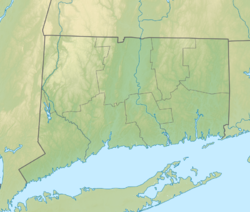| Shuttle Meadow Formation | |
|---|---|
| Stratigraphic range: Hettangian ~ | |
 Talcott Formation over Shuttle Meadow Formation in a quarry (Connecticut) | |
| Type | Geological formation |
| Unit of | Newark Supergroup Meriden Group |
| Underlies | Talcott Formation |
| Lithology | |
| Primary | Black shale |
| Other | Siltstone |
| Location | |
| Coordinates | 41°24′N72°42′W / 41.4°N 72.7°W |
| Approximate paleocoordinates | 22°06′N19°30′W / 22.1°N 19.5°W |
| Region | New England |
| Country | United States |
| Extent | Connecticut and Massachusetts |
The Shuttle Meadow Formation is a Mesozoic geologic formation in the Hartford Basin in Connecticut and Massachusetts, USA. [1] Insect fossils of Mormolucoides articulatus and dinosaur remains are among the fossils that have been recovered from the formation; Coelophysis sp . [2]

